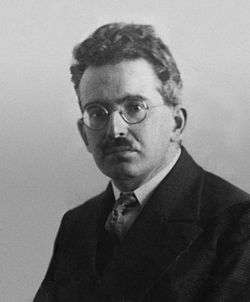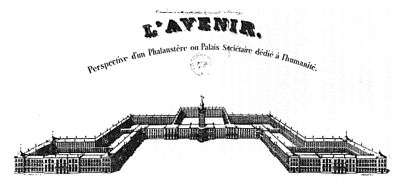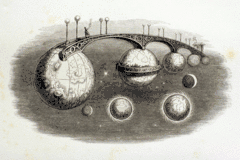Paris, Capital of the 19th Century
"Paris, Capital of the 19th Century" (1938) is one of a diptych of completed essays that was composed during the preparatory outlining and drafting phase of Walter Benjamin's uncompleted composition of the Arcades Project. "The Paris of the Second Empire in Baudelaire" is its sister essay. The major themes of The Arcades Project—the construction of the Parisian arcades in the early 19th century, their blossoming as a habitat for the flâneur, their demolition during Haussmanization—appear as leitmotifs in both essays.[1][2][3][4][5]

"Paris, Capital of the 19th Century" is a sketch or outline of the Arcades Project much in the same manner that Grundrisse was Karl Marx's outline for his intended eight volume masterwork Das Kapital of which he was only able to complete one volume. Whereas its sibling essay focuses on the poetry of Baudelaire as a microcosm for the full scope of ideas that Benjamin intended to address in the Arcades Project, "Paris, Capital of the 19th Century" attempts to cover the full-spectrum of themes whose development was ultimately intended.
History
In the late twenties, Walter Benjamin began to collect material and ideas for a history of the emergence of urban commodity capitalism in Paris around 1850 (this study eventually evolved into The Arcades Project).[1] In 1935, while Benjamin was living in exile in France, Fritz Pollock (co-director "of the Frankfurt School) suggested that Benjamin produce an exposé of the project, which came out in the form of the essay "Paris, Capital of the 19th Century."
Summary
"The Paris of the Second Empire in Baudelaire" is organized into six sections: (1) Fourier, or the Arcades; (2) Daguerre, or the Panoramas; (3) Grandville, or the World Exhbitions; (4) Louis-Phillippe, or the Interior; (5) Baudelaire, or the Streets of Paris; (6) Hausmann, or the Barricades. Each section-title pairs an important figure from the city's history with a contemporary innovation in architecture local to Paris.
Fourier, or the Arcades

The construction of the Arcades in the earlier half of the 19th century is described as well as attendant innovations (eg. "The arcades are the scene of the first gas lighting." [4] The construction of the arcades is coextensive with "the advent of building in iron.").[4] The new methods requisite for the construction of the arcades grow out of the innovation of pre-fabricated iron-rails for the new rail transportation system which is beginning to be built around the world at this time.
Benjamin observes that antique design concepts mingle with futuristic design concepts in the layout and decoration of the arcades, and he compares the project of the Arcades as a market-driven incarnation of Fourier's phalanstery, a type of building designed for a self-contained utopian community that was "supposed to lead men back to the condition in which virtue is superfluous."[4]
Daguerre, or the Panoramas
.jpg)
Benjamin builds an analogy between the Fourier's innovations and Louis Daguerre's. "As architecture begins to outgrow art in the use of iron construction, so does painting in the panoramas."[4] Daguerre begins as a panorama painter, a genre of painting whose climax coincides with the appearance of the arcades (which would often be decorated with panoramic paintings). "There were tireless exertions of technical skill to make the panoramas the scenes of a perfect imitation of nature, reproducing the changing time of day, the rising of the moon, the rushing of the waterfall."[4] Mid-career Daguerre invents an early model of the camera.
As Benjamin observes, "Photography leads to the annihilation of the portrait minitiaturist," and changes the discipline of painting significantly. "[Photography's] importance becomes greater the more questionable, in face of the new technical and social reality, the subjective element in painting and graphic information is felt to be... Photography for its part has...enormously expanded the scope of the commodity trade by putting on the market in unlimited quantities figures, landscapes, events that have either not been salable at all or have been available only as pictures for single customers." [4]
Grandville, or the World Exhibitions

Here Benjamin examines the way in which the World Exhibitions (preceded by National Industrial Exhibitions) give birth to the entertainment industry and for the first time begin to cultivate workers as consumers, providing a foundation for the transformation of the world and its contents into commodities. He analyzes the extent to which the illustrations of Grandville portray this process. As Benjamin writes, "Fashion prescribes the ritual according to which the commodity fetish wishes to be worshipped; Grandville extends fashion's claims both to the objects of everyday use and to the cosmos," disclosing the nature of fashion which, "resides in its conflict with the organic. It couples the living body to the inorganic world. Against the living it asserts the rights of the corpse. Fetishism, which is subject to the sex appeal of the inorganic, is its vital nerve. The cult of commodities places it in its service."[4]
Louis Phillipe, or the Interior
In this section, Benjamin explores the advent of apartments and interior decoration. "For the private person, living space becomes, for the first time, antithetical to the place of work." The apartment "entombs" the traces of its occupant.
Baudelaire, or the Streets of Paris
Michael Jennings[1] writes that:
"The pages given over to Baudelaire (in "Paris, Capital of the 19th Century") are perhaps the densest in the essay. Benjamin presents, in dizzying abbreavture [sic], a number of the central motifs of his critique of modernity: the flâneur strolls through the urban crowd as prosthetic vehicle of a new vision; the department store as phantasmagoric space of display and consumption; the commercialization and final alienation of the intelligentsia; the prostitute as concatenated image—of death and woman, 'seller and sold in one'; the gradual denaturing of art as it is subsumed by commodification and fashion, and the replacement of experience by the new concept of information."[1]
Haussman, or the Barricades
This section describes the co-evolution of Haussman's renovation of Paris, and the advent of modern finance capital. Benjamin writes that:
"Paris experiences a flowering of speculation. Playing the stock exchange displaces the game of chance in the forms that had come down from feudal society. To the phantasmagorias of space to which the flâneur abandons himself, correspond the phantasmagorias of time indulged by the gambler. Gambling converts time into a narcotic. Lafargue declares gaming an imitation in miniature of the mysteries of economic prosperity."
According to Benjamin scholar Michael Jennings, the concept of "phatasmagoria" is pervasive in Benjamin's later writings on Baudelaire. Originally an eighteenth-century illusionistic optical device by which shadows of moving figures were projected onto a way or screen, phantasmagoria, as Benjamin uses the term to evoke the network of commodities when they function within extensive networks, suppressing human rational capacities and appealing instead to the emotions, much as a religious fetish appeals to and organizes a religious belief structure.
See also
- The Frankfurt School
- Marxist hermeneutics
References
- Benjamin, Walter (2006). The writer of modern life: essays on Charles Baudelaire. Jennings, Michael William. Cambridge, Mass.: Harvard University Press. pp. 2, 8, 10, 18. ISBN 0-674-02287-4. OCLC 67922600.
- Benjamin, Walter (1997). Charles Baudelaire: a lyric poet in the era of high capitalism. London: Verso. ISBN 1-85984-192-9. OCLC 37242943.
- Benjamin, Walter (1996–2003). Selected writings. Bullock, Marcus Paul; Jennings, Michael William; Eiland, Howard; Smith, Gary. Cambridge, Mass.: Belknap Press. ISBN 0-674-94585-9. OCLC 34705134.
- Benjamin, Walter (1986). Reflections: essays, aphorisms, autobiographical writing. Demetz, Peter. New York: Schocken Books. pp. 147, 148, 149, 150, 153. ISBN 0-8052-0802-X. OCLC 12805048.
- Benjamin, Walter (1999). The arcades project. Tiedemann, Rolf. Cambridge, Mass.: Belknap Press. ISBN 0-674-04326-X. OCLC 41176710.